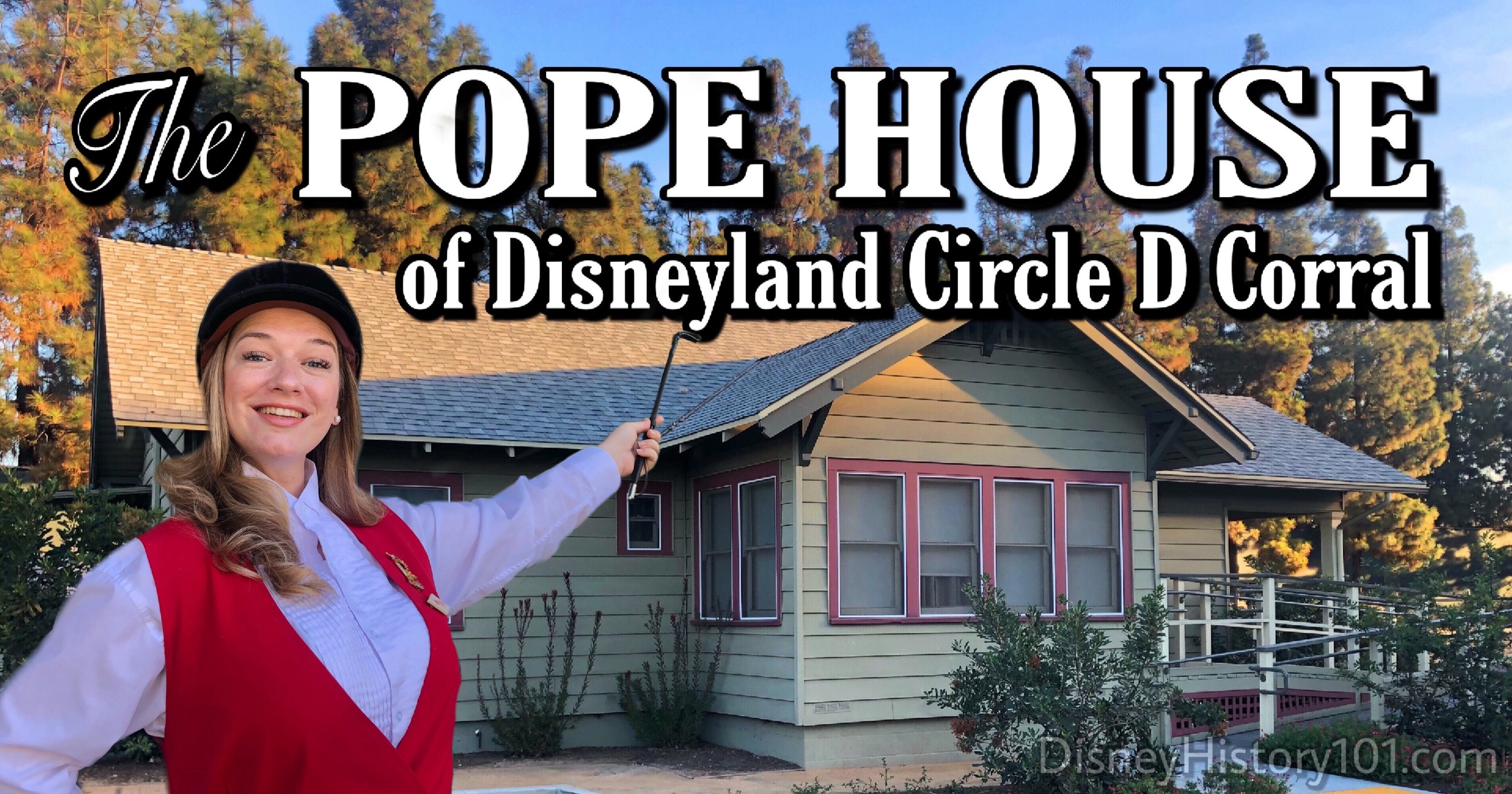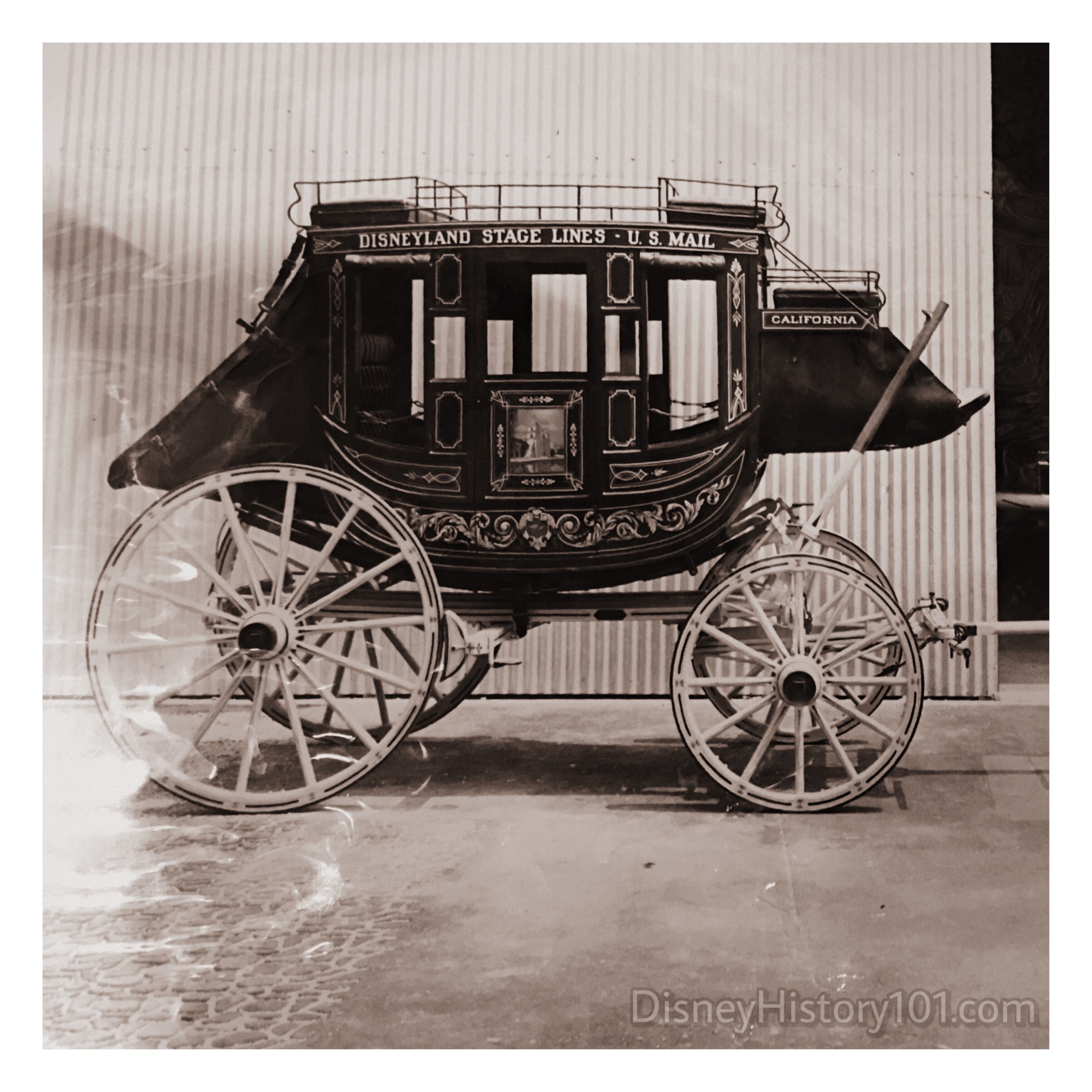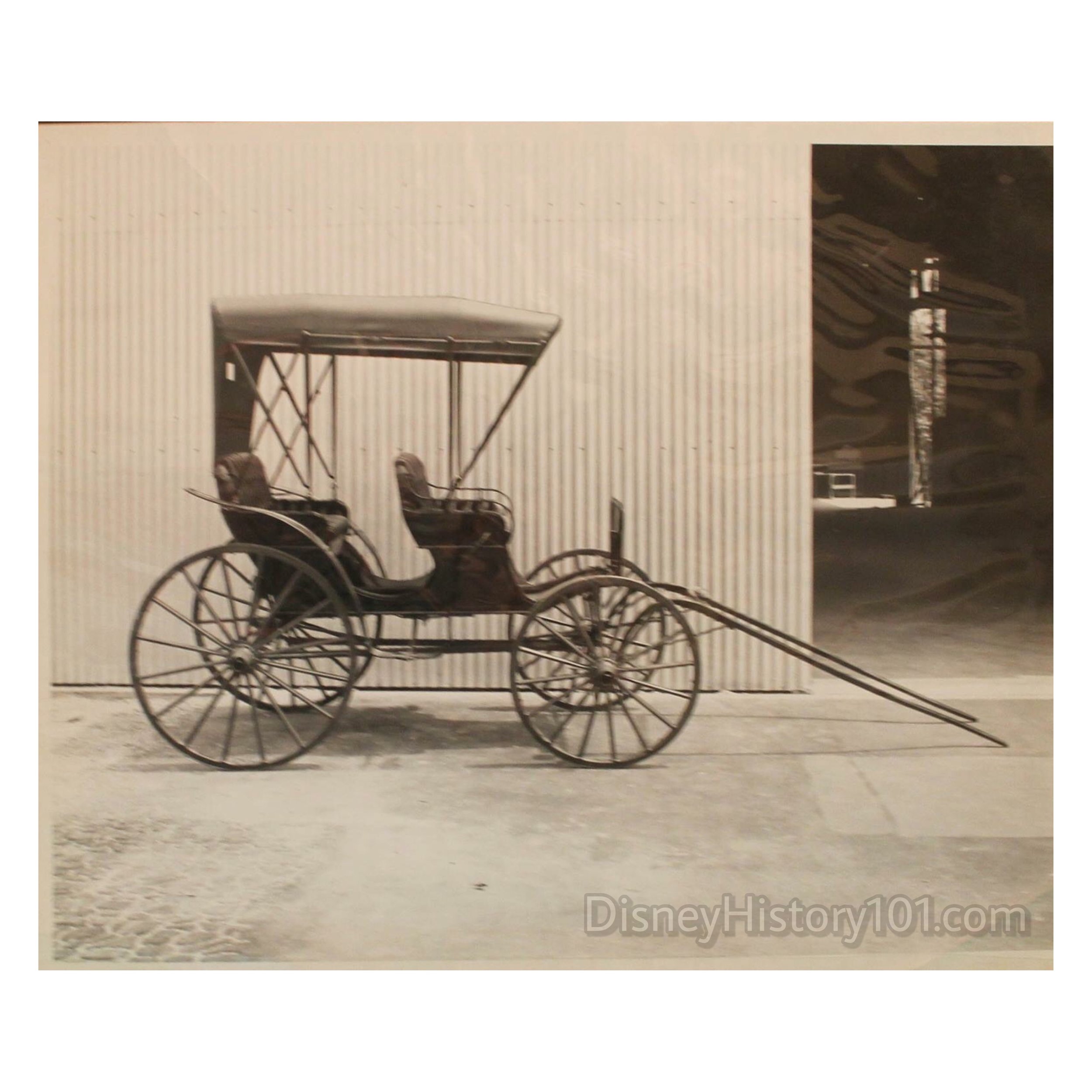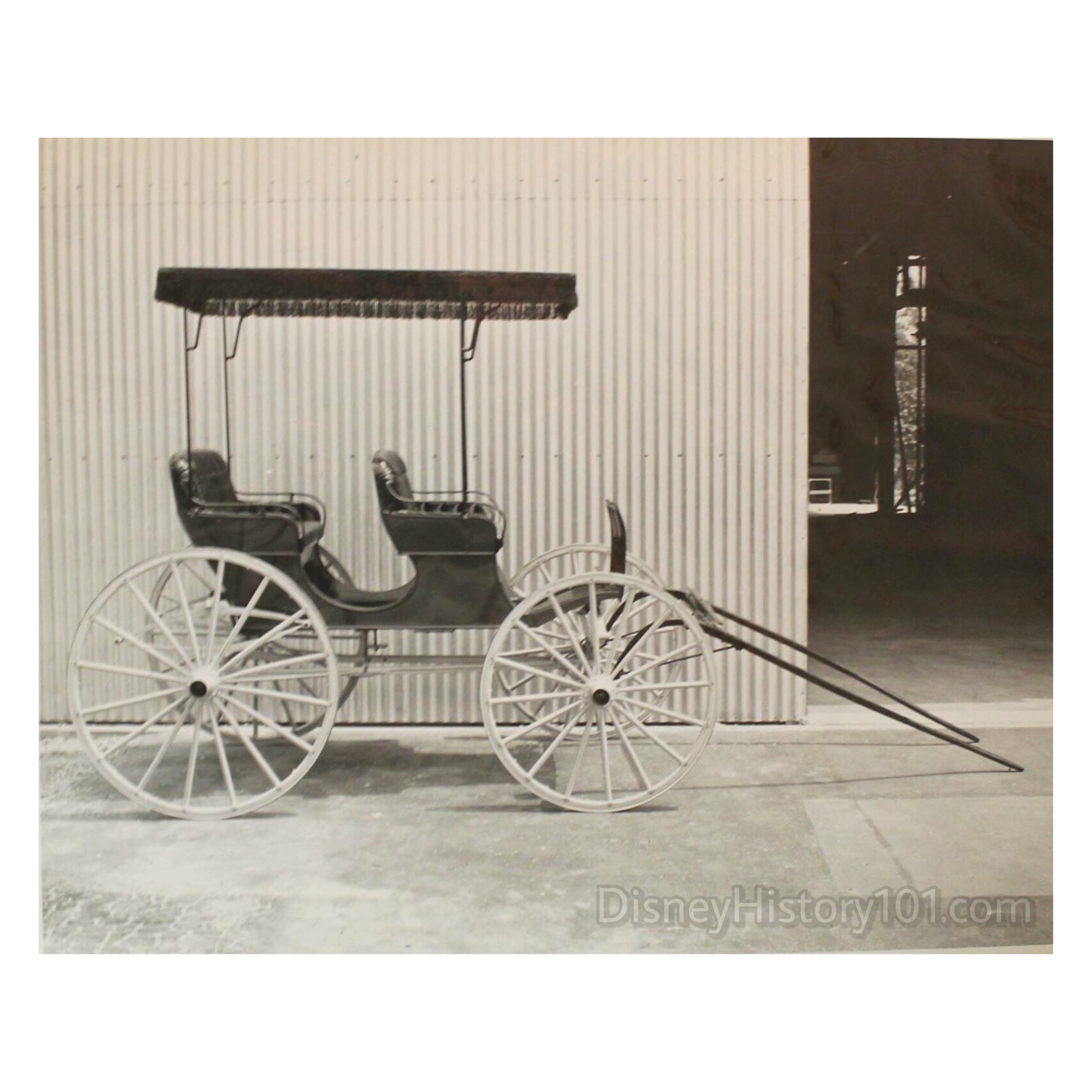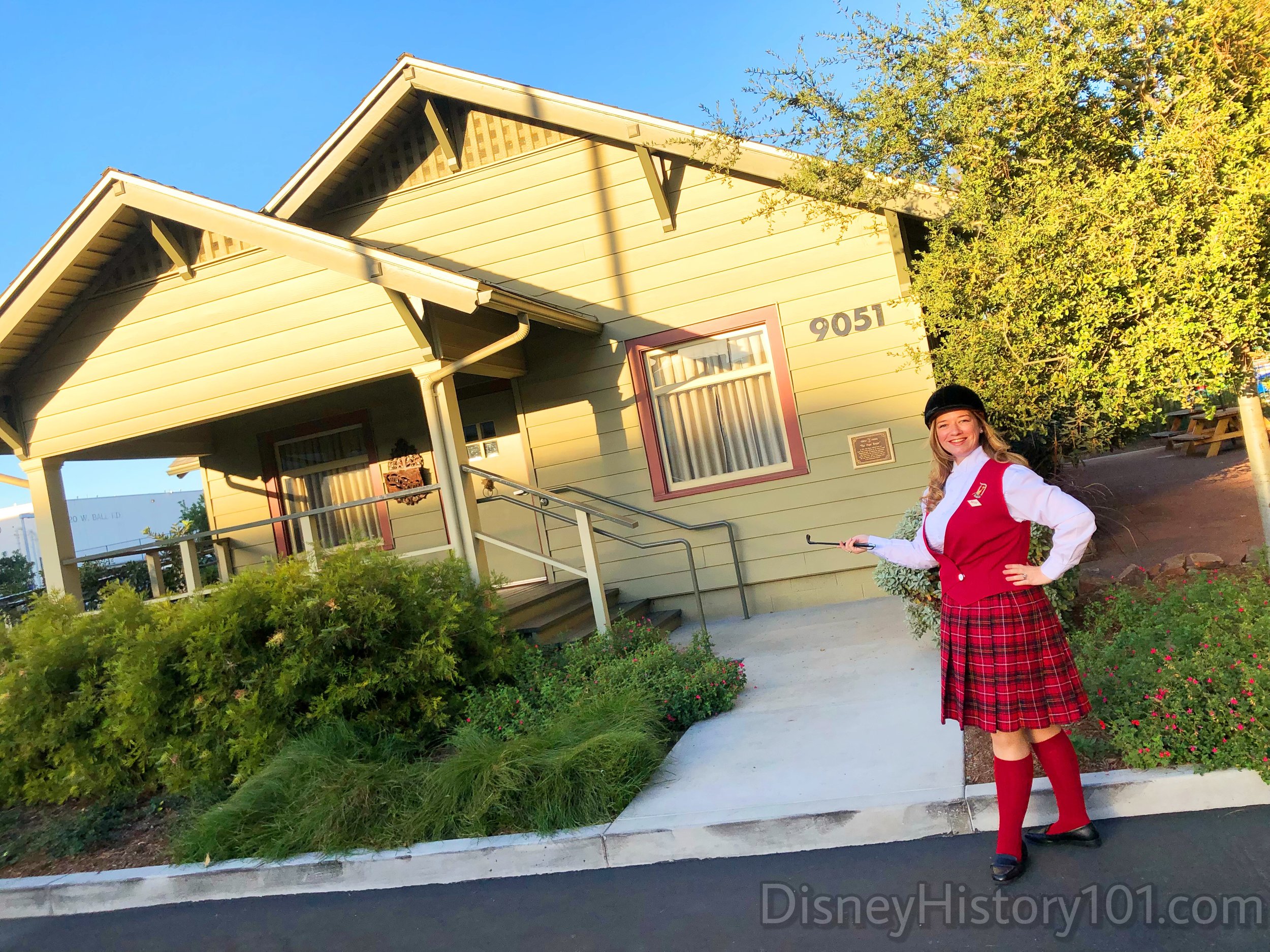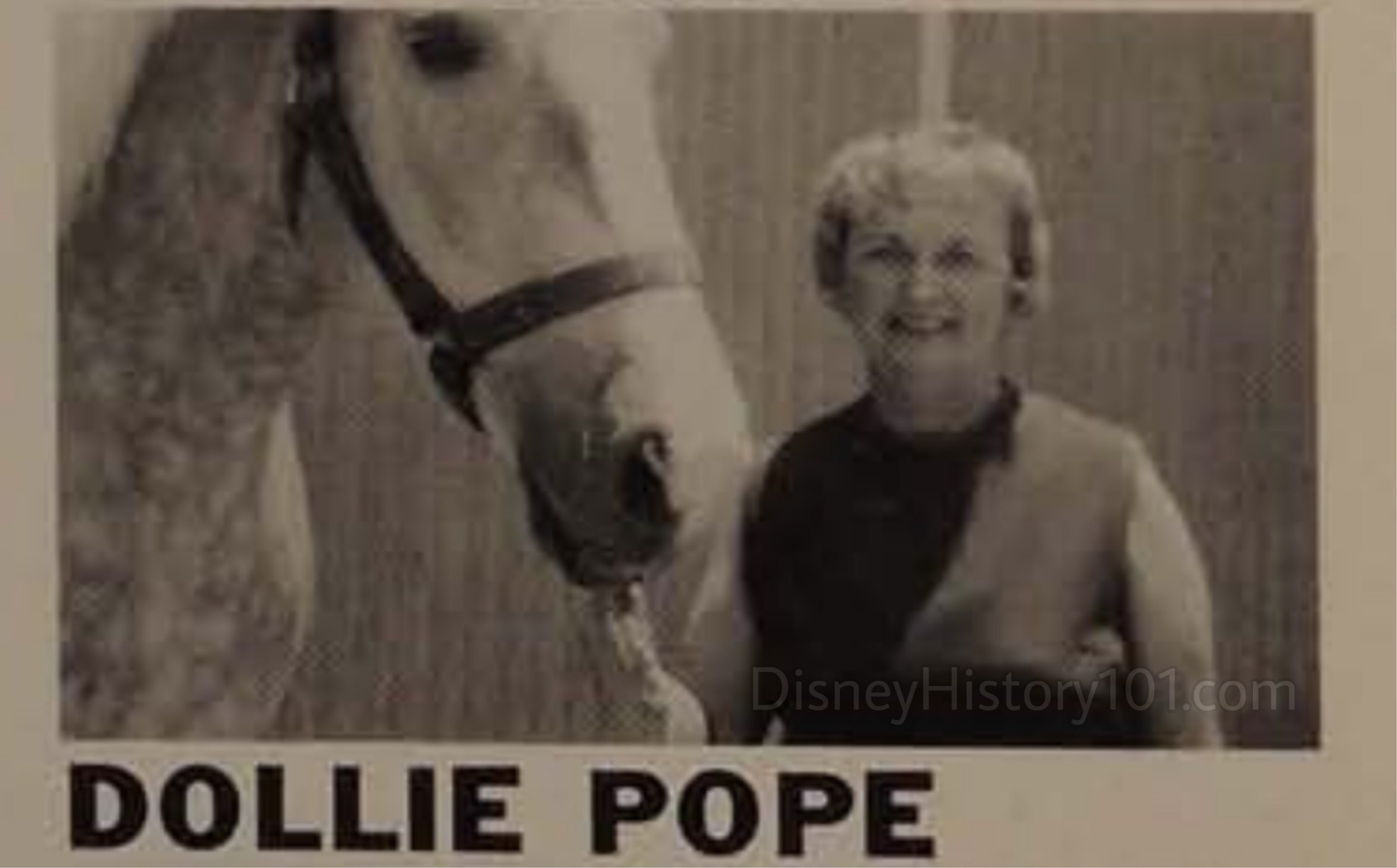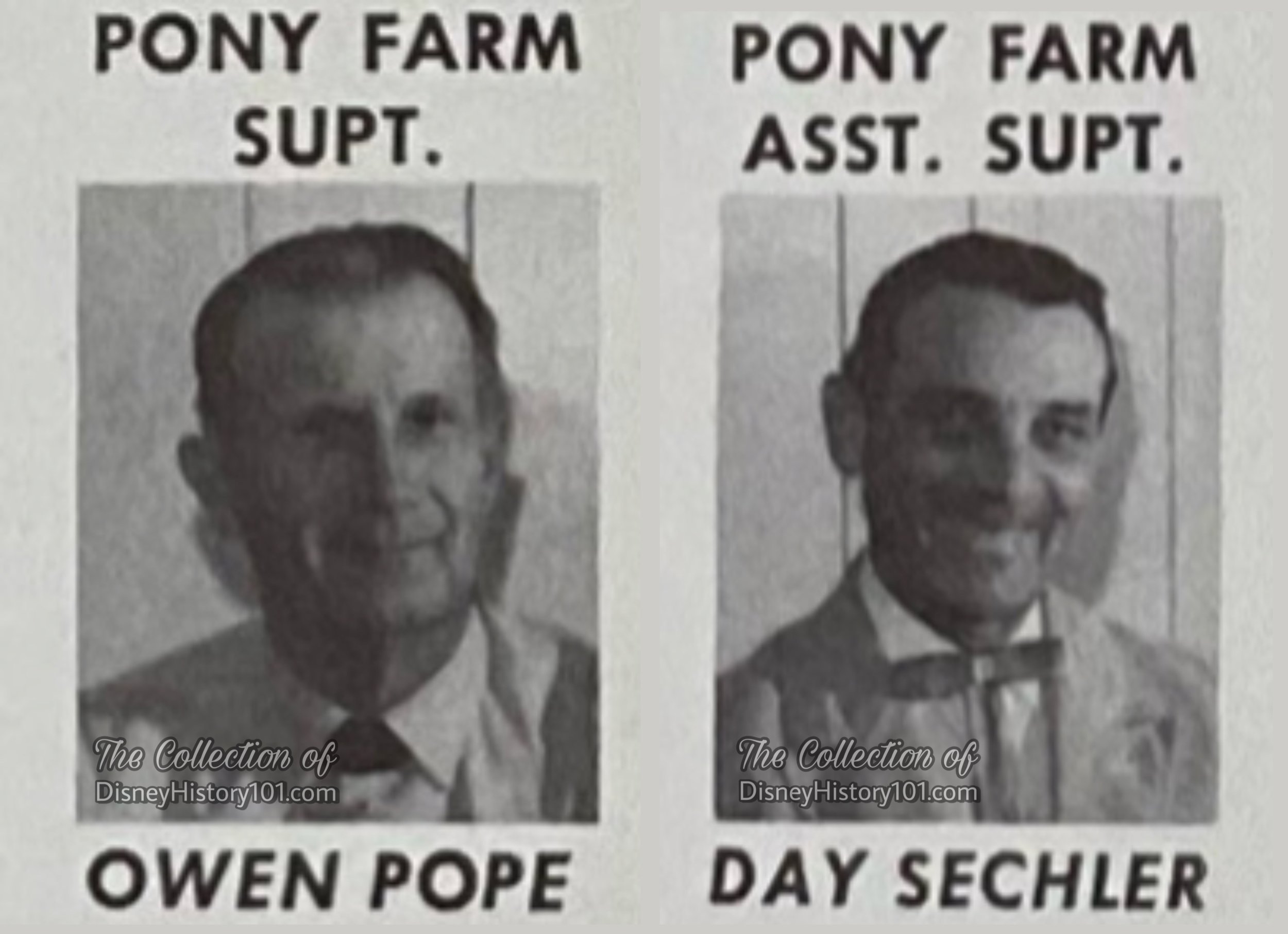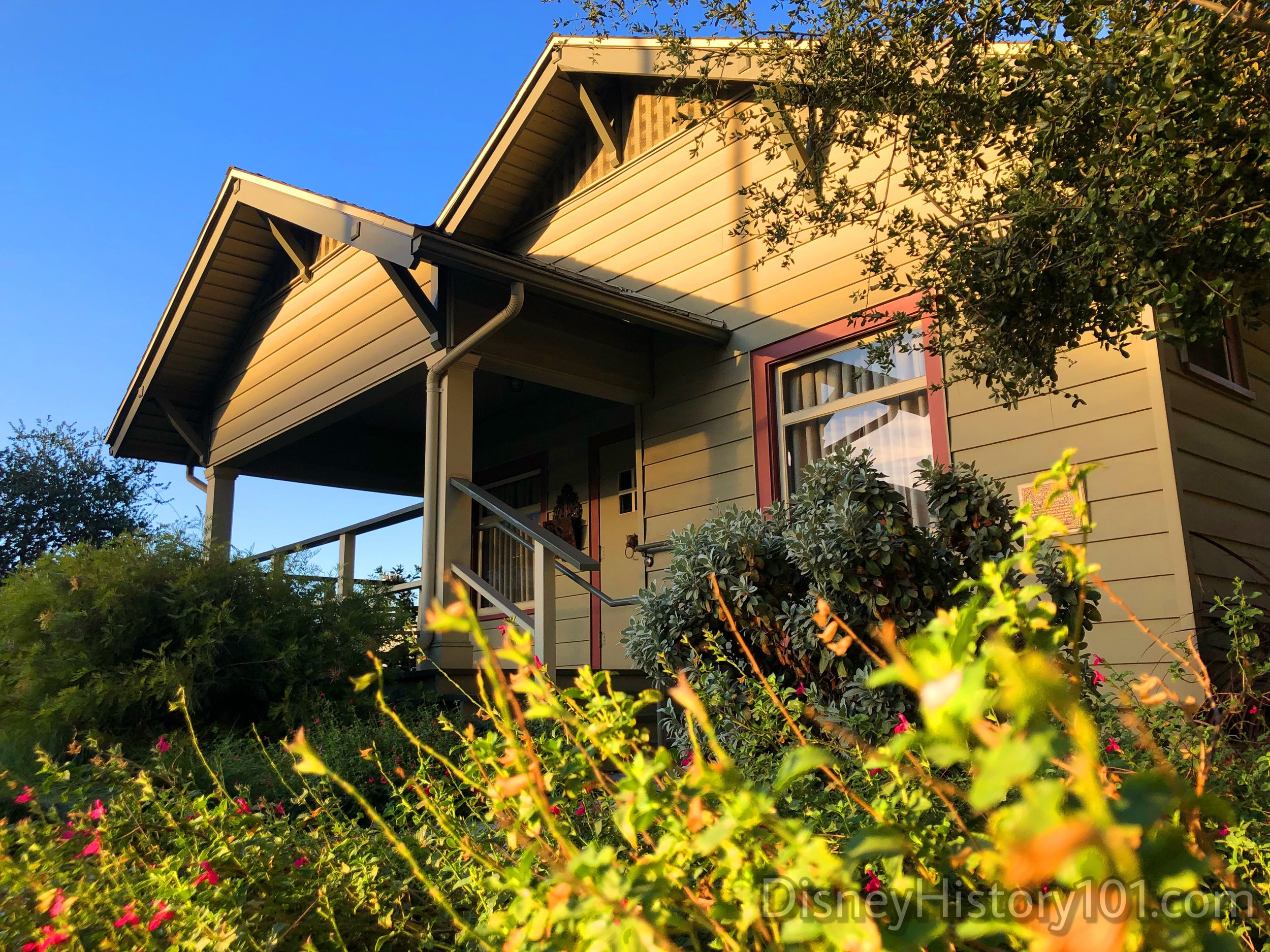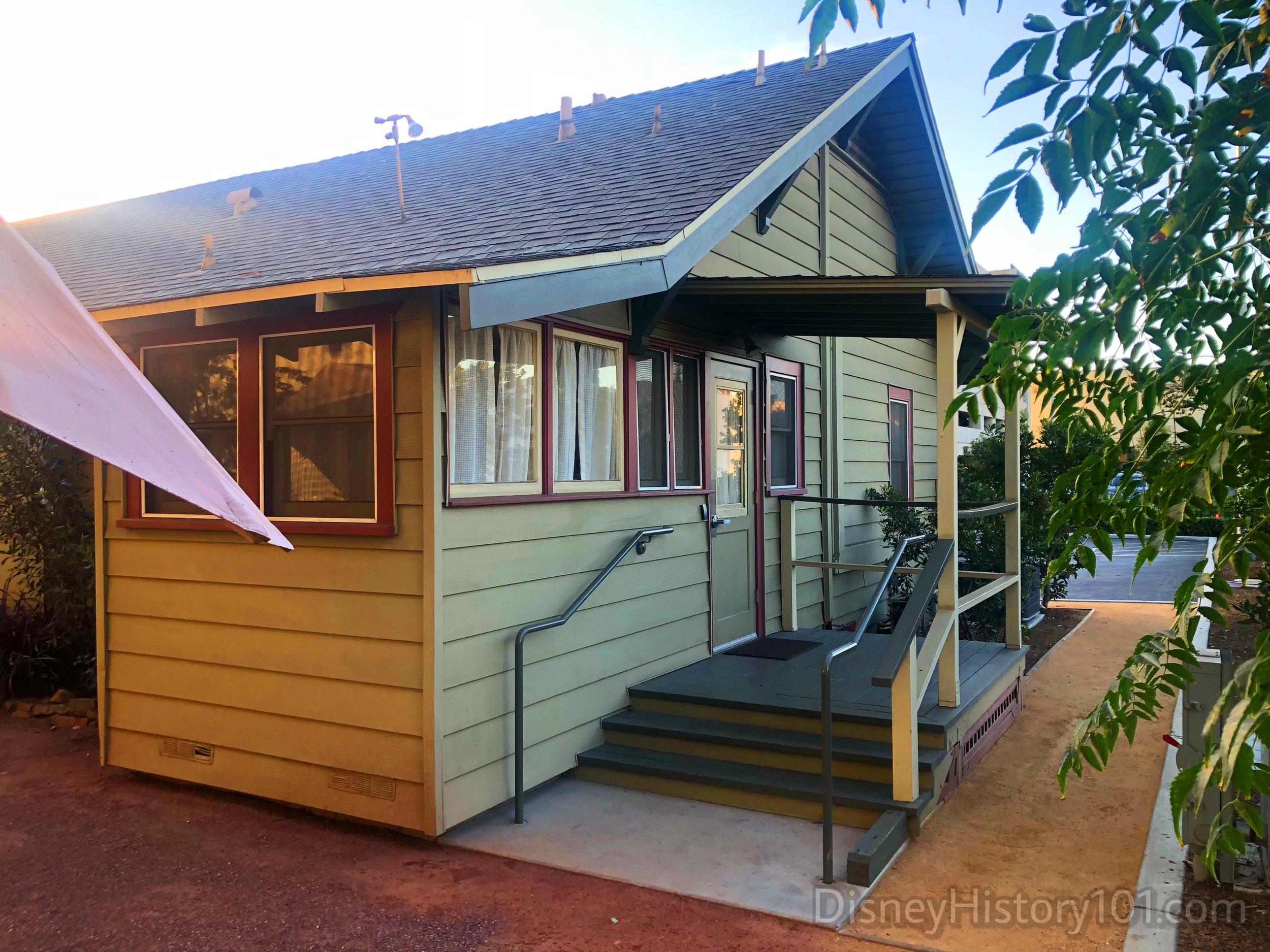Disneyland Resort, 9051 Cast Place, Anaheim, Ca 92802
Not far from where the original Disneyland marquee once stood on Ball Road, sits one of the oldest structures on Disneyland property. Step this way, as we explore the history behind the “Pope House”!
PLEASE, STEP THIS WAY as we explore the biggest mystery of the ghost farm of Disneyland and visit one of the oldest buildings of Backstage Disneyland - The POPE HOUSE!
“Walt Disney & the Little Witherill House”
The story of the little house begins in 1914, on a little country road which ran through farm groves of orange, avocado, walnut and apricot trees. There (at 10641 Harbor Boulevard), a modest little house was constructed by two newlyweds (much like the plot of Walt Disney’s c. 1952 adaptation of Virginia Lee Burton’s “The Little House”). The couple proceeded to live their lives in the home surrounded by the peaceful setting of their own walnut and apricot trees - for some four decades. All the while, a young Chicago boy (who was enamored with trains, animals, and drawing) would grow up to produce short films starring one of the world’s most beloved animated characters, and (unbeknownst to the Witherills, or anyone) these pursuits would his life on a course that would intersect with the Witherills in a way that no one could have imagined!
While Walt Disney was entertaining the world for several decades (through the medium of the silver screen), he began to personally entertain ideas for some sort of themed park. As far back as 1932 (and a year before his first daughter Diane was born), Walt began to dream about creating an amusement park (confirmed by c. 1932 sketches found at Walt Disney Studio in 1956). Various pursuits and projects would result in not much being recorded about these plans for about a decade. But later, some things were recalled to mind (at an unlikely time) while spending time with his family. In the words of Walt Disney (in interview with Fletcher Markle, in 1963) : “It came about when my daughters were very young and Saturday was always Daddy’s day with the two daughters… So we’d start out and try to go someplace. You know, different things. And I’d take them to the merry-go-round and I took them different places and as I’d sit there while they rode the merry-go-round… sit on a bench, you know, eating peanuts - I felt that there should be something built, some kind of amusement enterprise, where the parents and the children could have fun together… Well, it took many years. It was a whole period, maybe 15 years developing. We started with many ideas. Threw them away, started all over again.”
By April of 1953, Stanford Research Institute was hired by Walt, and began analysis on a suitable and sizable plot of land that had the potential to hold his “Disneylandia.” Both Cornelius Vanderbilt Wood and Harrison Price (Stanford Research Institute mechanical engineers) helped locate 10 potential Southern California locations for Walt Disney’s “Magic Kingdom.” But of these, Walt and Stanford Research Institute decided upon a rural area in the Ball Road Subdivision of Orange County. This was an agricultural community was selected just down the country road from the little Witherill farm.
On May 5th, 1954, Linnaeus D. and Grace A. Witherill sold their property (and houses) to Disneyland, Inc. Linnaeus was very involved in the Anaheim community - both an active Mason (Los Angeles Shrine and Scottish Rite), and Santa Ana Elks Lodge member. Though there were many opposed to the Disneyland land annexes, the Witherills were supportive of the development. Frank Pfannenstiel came to Disneyland on May 31, 1954, as a stable man.” Construction officially commenced about two months later on July 21, 1954. Sadly, Linnaeus passed in 1955, never coming to a full understanding of the impact that his business transaction with Walt Disney would have on his neighborhood, community, and the world.
“The Hitching of the ‘Horsemasters’ - Owen and Dollie Pope”
Owen and Dollie got “hitched”. According to Disneyland Backstage magazine, Summer 1965 :
“Dollie met Owen in Fort Worth, Texas when she was 16 years old. They were married five years later.” The pair shared a passion for all things equestrian! Owen had learned to weld during World War II. Later, he designed a new kind of trailer and in 1949 the couple went out to the Cow Palace in San Francisco to bring out this new hitch and show it. In the years that followed, Owen continued to build custom trailers for horses and travel from horse show to horse show with a “hitch” of eight to ten Shetland stallion ponies, winning recognition and prizes.
“The Popes Get Wrangled into Working for Big ‘Hollywood Personality’ Walt Disney”
During 1950, the Popes were running a show at the Pan Pacific Auditorium (in Sacramento), and Disneyland production artist Harper Goff attended. The Popes were exhibitioning their prize “‘hitch’ of ten Shetland pony stallions,” according to Backstage Disneyland (Summer of 1966). After meeting Walt in 1951, Harper recommended their show to Walt, and Walt visited the Cow Palace Show. Walt was so impressed with the showmanship and their ponies that he started to figure out a way to contact the Popes. Dollie recalled: “In '51 he started looking for us. The Librarian at the Studio started writing all over, and a letter finally reached us, asking about our horses and equipment. I wrote a letter back telling them that Owen had manufactured his own equipment, harnesses and so forth, and she sent a letter back asking us to come and meet Walt.” Walt arranged a meeting with the couple during the spring of 1951.
D23 (The Official Disney Fan Club) states, “The Popes, Owen and Dolly, were hired by Walt Disney in November 1951 to start putting together some livestock for his future park.” Disney Parks Blog gives us a more exact date of hire when it states : “On the Sunday after Thanksgiving in 1951, they moved to the Walt Disney Studio in Burbank.” According to Dollie, “Owen actually started work at the Studio in January of 1952” (mostly on Walt’s personal payroll, from his own personal bank account) and Dollie started later at Disneyland in 1955. Originally, Walt wanted to build a small cart for children, and Owen rented and built some coaches which were scaled down for kids.
What other work did Owen and Dollie perform for Walt?
The Popes clearly had the “horse sense” to raise and train the livestock for their new responsibilities at Disneyland. “Walt Disney Disneyland” (published 1964) describes how “in the weeks before the Park’s opening, the horses were ‘entertained.’ They pranced around a circular ring for hours each day while music, tooting, automobile horns and the sounds of crowds of people wafted in their ears.” This the horses did for “four hours a day while tape recordings were used to simulate the sounds they would be hearing,” according to Backstage Disneyland (Summer of 1966). Van Arsdale France adds: “He was worried about the horses ‘spooking’ with all the sights and sounds of Disneyland. So, a recording of sounds from arcades and shooting galleries, and yelling kids made up. This was used as an audio aid for horse training. Since the horses were not directly on the payroll, they had to be carried as assets. All were given names. They all received names of people in accounting. Lucy Cotton, for example had a mule on the records named, ‘Lucy Mule.’”
The Popes also oversaw crafting equine-related gear. As far back as Disneyland’s earliest planning stages (as evidenced in a few production drawings of a Mickey Mouse park in Burbank), stagecoaches, buckboards, and wagons were to be some of the main attractions. Just take a look at the following document. The earliest concepts for Disneyland even suggested that “the Mail-Order Catalogue will picture everything for sale in the Emporium or at any place in Disneyland. If you want a real pony and cart or a miniature donkey thirty inches high you’ll find it in the catalogue.”
According to page 10 of this version of the 1954 Disneyland Prospectus, Walt planned on “200 ponies operating out of Disneyland,” drawing stagecoaches through the Painted Desert!
During the aforementioned 1951 meeting Walt displayed a strong interest in the Owen’s skill set for his Disneyland project, and Owen and Dolly Pope were swiftly hired to breed and train miniature ponies, horses, and other animals to be featured inside Disneyland. The Popes agreed to supervise the construction of these wagons, stagecoaches, and buckboards that would be used in Frontierland, as well as the surreys that would run down Main Street USA. (Please CLICK the following image to view three photographs of their work featured in the 1954 Disneyland Prospectus. This portfolio gave a description of featured Disneyland attractions, and was shown to investors.) As the work was rigorous and Disneyland’s deadline neared, Walt arranged for the Popes to live in a trailer at the Burbank studio (as previously mentioned), starting in November of 1951. They stayed here for 2 1/2 years before their next move. Frank Pfannenstiel was “a cowpoke out at Hot Sulphur Springs, Colorado, riding a spread of 22,000 acres.” In 1954 he was working at the River Bottom in Burbank where all the stables are. On February 2, 1954 he “went to work for Owen Pope at the Studio making covered wagons and stage coaches and taking care of the horses.”
Van Arsdale France recalled the Popes he when first met Walt Disney (during the summer of 1954), stating: “there were just a few people on the payroll of what was called ‘Disneyland, Incorporated.’ Two of these, Owen Pope and his wife, Dolly, were living on the ‘studio’ grounds in a trailer and were raising and accumulating horses and ponies for Disneyland. A small well-dressed man named Nat Wyncoff came in with a book showing how the horse and pony acquisitions were being made.” [Backstage Disneyland - A Personal History by Van Arsdale France, page 3]
In 1954, Day Sechler went to the STUDIO, where he helped Owen Pope make street cars, surreys, stage coaches and even a fire engine. Day recalled: “My first day on the job at the STUDIO,… Walt[sic] came through the shop and welcomed me to California and to Walt Disney Productions.”
The Stagecoaches were tested around the studio lot before Walt took one of them onto real rugged terrain of Palm Springs and Frontierland.
PHOTO : WALT DISNEY & OWEN POPE ride the California Disneyland Stagecoach during 1954. Before the Disneyland stagecoaches were utilized in the Palm Springs Desert Circus (near Smoke Tree Ranch), and the Anaheim Parade, Owen and Walt tested them on the Burbank studio backlot.
How did the Pope’s come to settle in this little homestead on Disneyland property?
In early 1954, 19.46 Acres were purchased for the Pony Farm and Nursery at $80,070. Before construction began, the value of the land was assessed - the trees were valued at $222,660, the wells were valued at $14,205, other aspects valued at $132,932, and the houses valued at $173,374. After all, three houses were wrecked, four houses were sold (one to the Disneyland Hotel, the other to the state), and the escrow was adjusted on eight houses. Some houses were retained and even utilized - two were combined to form the Administration Building, one was used for the Personnel & Purchasing Building, one utilized by the Sales Department Annex, one used by the Disneyland Recreational Club, one used for Park landscape sets, and two were used by the Pony Farm, in addition to the old Siewert residence. The two Pony Farm houses were used as residences for the Pony Ranch Superintendent and the Pony Ranch Foreman. As for the 10 acres of land that would become the Pony Farm and Nursery, it was owned in fee and leased to Disneyland, Inc.
The Popes had spent two-and-a-half years at the Studio. Three days before Disneyland opened, the Popes moved to their new home - Disneyland! While the 153.2 acres of level citrus groves were being transformed into rivers, lakes, mountains, and hills, zoning variances were obtained to include both commercial and residential use. The Popes had their choice of the houses being moved around on the property, and picked the humble “Witherill Bungalow” you see before you. The house (and one other) had been moved to the 10-acre area (along Winston Road) called the Pony Farm. The Pony Farm was tucked away near a true-life living desert in Frontierland (and about 100 yards behind Fantasyland), near the crossroads of stage coaches and railroad cars. There (along Winston Road), the Popes would settle (along with their horses), and the Pony Farm would come to have a barn, a shop, stables, and a corral. With the exception of Patrick Begorra’s little house, there were only two other houses on Disneyland Pony Farm property, making the position Owen and Dollie possessed truly rare and unique!
The Skyway Cabins often granted passing glimpses of the House, Saddle Room, Stable, Shop, Manure Bins, Feed Yards, Hay Rack, and Pony Farm behind Fantasyland.
It was in this house that Dollie worked for her husband at times during the summer months as a department clerk. According to Backstage Disneyland, Summer 1965 : “I take care of the time cards and the paper work that Owen doesn’t have time for.”
Owen and Dollie’s contributions may be forgotten by most, but during the 1960s they were the subject of numerous magazine articles. This photograph of Dollie Pope coincided with a brief story of her life in Disneyland BACKSTAGE, Summer of 1965.
The Pony Farm and Nursery comprised 19.46 acres, valued at $80,070 by 1954. In 1958, an appraisal by Bank of America analyzed both the Park and Pony Farm, valuing them on an operating basis. By September 28, 1958, the sheer value of the 10-acre Pony Farm and 2-acre Nursery land was valued at a whopping $440,000. The two residences (used by the Superintendent and Foreman) were reconned as Disneyland, Inc. Park assets valued at $11,036 and $11,128 (initially appraised at $8,000 and $10,000, plus $416 for some additional features to the latter).
Plot Plans of that later era depict the “House” located on the Southern part of the Backstage (along the old stagecoach access road leading to Onstage), but now surrounded by (2) Feed Yards (one for horses, the other for mules), a pigeon coop (or loft), the Pony Farm, a Hay Rack, Manure Bins, a Stable, a Shop, a Barn, a Saddle Room and Blacksmith Shop within the boundary of the Service Road. By 1958, some the hoof-branded livestock (some 35 burros, 30 crossbred ponies, 11 crossbred draft horses, and 5 small crossbred mules) were also being pastured (while fed on grass and alfalfa) at Rock Creek Ranch in Llano, California.
The Popes continued to live on this periphery property (north of the Main Park property) for 16 years, training and raising new heads of horses and other livestock (under the supervision of Doc Lemmon, Disneyland Operations). The Popes were assisted by experienced and caring hands as renown horse trainer for the stars Alton Howry (hired 1956) and Pony Farm Assistant Manager Marion Day Sechler, c.1966 - March of 1979. From 1959 to 1963, some “seventy-four livestock handlers” (34 drivers and 40 harness cleaners and stablemen) were maintaining the Disney stock of more than 200 head of livestock during the peak seasons.
By the second opening of Disneyland in 1959, many of the animals ranged from 3 years old to 16 years old (with average age 10 years). Under the supervision of Owen and Dollie, those aforementioned seventy-four hands would care for the employed livestock (stabling them and pasturing them), growing nursery stock, cleaning the Pony Farm, storing and maintaining horse-drawn vehicles and equipment, and maintaining the corrals. These also performed the tasks of feeding the livestock over a ton (25 bales) of hay, 1/2 ton of alfalfa and mollassas, and 400 lbs. of rolled barley that was consumed daily during peak seasons.
The Popes were also quite handy and continued to manufacture much of the tack and other equine-related equipment (like stirrups, harnesses, bridles, and riggings) used at Disneyland during the 1960s and 1970s. By 1966, the Pony Farm even included pigeon coops on the West side of the property. Even though they were nearing retirement age, they were soon tempted by another offer.
The Popes continued to work and live at Disneyland, until they moved to Florida to help establish the Tri-Circle-D-Ranch, which opened during the summer of 1976. The Tri-Circle-D-Ranch would become the home of all the horses serving Walt Disney World with saddle horses available for guided trail rides, a Petting Farm, and Pet Kennel. The number of Circle-D-Ranch Hosts and Hostesses would fluctuate from 17 in the summer to 9 during the fall.
“I Have An Idea” Submission to name the Pony Farm (by Jack Kehoe) and Official Response by Disneyland Operations, (1973). During this time the Owens’ old dwelling was still known as “the House.”
Four years after Tri Circle D Ranch opened at Walt Disney World (in September of 1975), Owen and Dolly Pope finally retired. As for their old Disneyland home (on the Disneyland Pony Farm), it continued to serve as an office for the Circle D Corral (which was newly renamed by Main Gate Ticket Seller Sandy Oleson in 1980). There, livestock handlers and caretakers continued some of the Pope’s work, in the very same place where Dollie once assisted her husband seasonally!
The plaque is now wall-mounted to the historic structure.
You may recall that many houses that originally stood on parcels that oddly become Disneyland were demolished in 1954 before construction began. While few had been repurposed, even those had long-since been removed. For instance, the old Callens House and Dominguez House (which had served as the Administration Building for some time) was demolished in 1958. Today, though removed from the location where Walt had placed it, it stands as “the only remaining house on the Disneyland property.”
Just beyond the front door, many relevant equestrian-related artifacts and photographs of Walt, the Popes, and Disneyland!
Decorative elements in the living room include photographs of one of the first foals that the Popes bred and raised for Walt Disney’s Pony Farm!
You can still find some of the Popes’ work hanging in the firehouse on Main Street U.S.A.!
The area where the Pope House stood was constantly being evaluated to improve Show Quality. In 2008, WDI master planners entertained the concept of a massive update that would have involved the Pony Farm Area utilized to complete circulation from its a small world through Mickey’s Toontown then back to a proposed “Festival Arena” (on the site of Big Thunder Ranch). Since the demolishment of Circle D Ranch and the construction of Star Wars : Galaxy’s Edge, the historic Pope house has been displaced from its “frontier” setting.
The Pope House has been made wheel chair accessible.
Certain inviting, homely touches are still present around the new property, including the swing.
The Pope House (the oldest structure on Disneyland property) has been moved from it’s original location at the corral (off the former Winston Road), to “Disneyland’s edge” (just off Ball Road). At the time of publishing this article, The Pope House has it’s home in the Cast Place Disneyland Employee Center Parking Lot near the Team Disney Anaheim Building.
No one lives here anymore, but the former residence has been used as an employee meeting room from time to time. Here, visitors will note that the house remains furnished in a simple fashion, similar to how it’s previous tenants left it. Though it is currently not open to the public at this time, it isn’t hard to visit the exterior of the historic house after business hours and pay homage to the home of the original caretakers of Disneyland - a symbol of true employee dedication and service! Thank you for joining us today for our tour of The Pope House. I look forward to seeing you again for our next Disney History 101 Field Trip!


